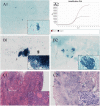BRAFV600E mutation test on fine-needle aspiration specimens of thyroid nodules: Clinical correlations for 4600 patients
- PMID: 34851044
- PMCID: PMC8704181
- DOI: 10.1002/cam4.4419
BRAFV600E mutation test on fine-needle aspiration specimens of thyroid nodules: Clinical correlations for 4600 patients
Abstract
Background: The BRAFV600E mutation is valuable for the diagnosis, prognosis, and therapy of papillary thyroid cancer (PTC). However, studies related to this mutation have involved only a small number of patients. Therefore, we performed a large-scale analysis from a single institute to evaluate the accuracy of combined fine-needle aspiration (FNA) and BRAFV600E mutation tests for PTC diagnosis.
Methods: A total of 4600 patients with thyroid nodules who underwent both FNA cytology and BRAFV600E mutation analysis on FNA specimens were enrolled. The association between the BRAFV600E mutation and clinicopathological features was analyzed. A separate analysis was performed for the 311 patients who underwent repeated FNA for comparison of cytological evaluation and BRAFV600E mutation results. The diagnostic efficacy of the BRAFV600E mutation test and cytologic diagnoses was evaluated for 516 patients who underwent preoperative FNA tests in comparison with conclusive postoperative histopathologic results.
Results: The cytology results of all 4600 FNA samples were categorized according to The Bethesda System for Reporting Thyroid Cytology (TBSRTC) stages I-VI, which accounted for 11.76%, 60.02%, 6.46%, 3.61%, 6.71%, and 11.43% of the samples, respectively. The BRAFV600E mutation was detected in 762 (16.57%) FNA samples, with rates of 1.48%, 0.87%, 20.20%, 3.01%, 66.02%, and 87.81% for TBSRTC I-VI lesions, respectively. Among the 311 repeat FNA cases, 81.0% of the BRAFV600E -positive and 4.3% of the BRAFV600E -negative specimens with an initial indication of cytological non-malignancy were ultimately diagnosed as malignant by repeat FNA (p < 0.001). Among the 516 patients who underwent thyroidectomy, the sensitivity and specificity of the BRAFV600E mutation test alone for PTC diagnosis were 76.71% and 100.0%, respectively, which increased to 96.62% and 88.03%, respectively, when combining the BRAFV600E mutation test with cytology. BRAFV600E mutation was significantly associated with lymph node metastasis (p < 0.001), but not with age, gender, or tumor size.
Conclusions: The BRAFV600E mutation test in FNA samples has potential to reduce false negatives in PTC diagnosis, and therefore plays an important role in the diagnosis of thyroid nodules, especially those with an indeterminate or nondiagnostic cytology, which should be considered for repeat FNA.
Keywords: BRAFV600E mutation; cytology; fine-needle aspiration; thyroid nodules.
© 2021 The Authors. Cancer Medicine published by John Wiley & Sons Ltd.
Conflict of interest statement
The authors declare that they have no competing interest.
Figures

Similar articles
-
Diagnostic Value and Challenges of BRAF V600E Molecular Testing and Thyroid Fine-Needle Aspiration Cytology: A Retrospective Study from a Tertiary Institution in Southern Hunan Province, China.Acta Cytol. 2023;67(6):629-638. doi: 10.1159/000534138. Epub 2023 Sep 14. Acta Cytol. 2023. PMID: 37708867
-
The Combined Use of Fine-Needle Aspiration (FNA) and BRAF V600E Gene Testing: Can it Increase the Definitive Diagnosis Rate of Nodules Categorized as Bethesda III for Papillary Thyroid Carcinoma?Am Surg. 2024 Dec;90(12):3209-3215. doi: 10.1177/00031348241265143. Epub 2024 Jul 24. Am Surg. 2024. PMID: 39047144
-
Fine-needle Aspiration Washout Precipitation Specimens: An Acceptable Supplement to Genetic Mutation Detection of Thyroid Nodules.Technol Cancer Res Treat. 2021 Jan-Dec;20:15330338211057982. doi: 10.1177/15330338211057982. Technol Cancer Res Treat. 2021. PMID: 34806478 Free PMC article.
-
Testing for BRAF (V600E) Mutation in Thyroid Nodules with Fine-Needle Aspiration (FNA) Read as Suspicious for Malignancy (Bethesda V, Thy4, TIR4): a Systematic Review and Meta-analysis.Endocr Pathol. 2020 Mar;31(1):57-66. doi: 10.1007/s12022-019-09596-z. Endocr Pathol. 2020. PMID: 31811566
-
BRAFV600E mutation as a predictor of thyroid malignancy in indeterminate nodules: A systematic review and meta-analysis.Eur J Surg Oncol. 2017 Jul;43(7):1219-1227. doi: 10.1016/j.ejso.2016.11.003. Epub 2016 Nov 22. Eur J Surg Oncol. 2017. PMID: 27923591
Cited by
-
Role of contrast-enhanced ultrasound with time-intensity curve analysis about thyroid nodule and parenchyma for differentiating BRAF V600E mutation status.PeerJ. 2025 Feb 25;13:e19006. doi: 10.7717/peerj.19006. eCollection 2025. PeerJ. 2025. PMID: 40028210 Free PMC article.
-
BRAF Detection in FNAC Combined with Semi-Quantitative 99mTc-MIBI Technique and AI Model, an Economic and Efficient Predicting Tool for Malignancy in Thyroid Nodules.Diagnostics (Basel). 2024 Jun 30;14(13):1398. doi: 10.3390/diagnostics14131398. Diagnostics (Basel). 2024. PMID: 39001288 Free PMC article.
-
Combining radiomics and molecular biomarkers: a novel economic tool to improve diagnostic ability in papillary thyroid cancer.Front Endocrinol (Lausanne). 2024 Aug 14;15:1378360. doi: 10.3389/fendo.2024.1378360. eCollection 2024. Front Endocrinol (Lausanne). 2024. PMID: 39205691 Free PMC article.
-
The value of Korean, American, and Chinese ultrasound risk stratification systems combined with BRAF(V600E) mutation for detecting papillary thyroid carcinoma in cytologically indeterminate thyroid nodules.Endocrine. 2024 May;84(2):549-559. doi: 10.1007/s12020-023-03586-2. Epub 2023 Nov 9. Endocrine. 2024. PMID: 37940765
-
BRAF V600E mutation in thyroid carcinoma: a large-scale study in Han Chinese population.World J Surg Oncol. 2024 Sep 28;22(1):259. doi: 10.1186/s12957-024-03539-7. World J Surg Oncol. 2024. PMID: 39342349 Free PMC article.
References
-
- Bernet VJ, Chindris AM. Update on the evaluation of thyroid nodules. J Nucl Med. 2021;62(Suppl 2):13S‐19S. - PubMed
-
- Lee Y‐B, Cho YY, Jang JY, et al. Current status and diagnostic values of The Bethesda System for Reporting Thyroid Cytopathology in a papillary thyroid carcinoma‐prevalent area. Head Neck. 2016;39(2):269‐274. - PubMed
-
- Cibas ES, Ali SZ. The Bethesda System for Reporting Thyroid Cytopathology. Am J Clin Pathol. 2009;132(5):658‐665. - PubMed
-
- Cibas ES, Ali SZ. The 2017 Bethesda System for Reporting Thyroid Cytopathology. Thyroid. 2017;27(11):1341‐1346. - PubMed
Publication types
MeSH terms
Substances
LinkOut - more resources
Full Text Sources
Medical
Research Materials

